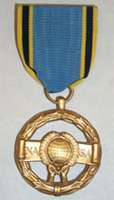NASA Exceptional Service Medal
The NASA Exceptional Service Medal is an award granted to U.S. government employees for significant sustained performance characterized by unusual initiative or creative ability that clearly demonstrates substantial improvement in engineering, aeronautics, space flight, administration, support, or space-related endeavors which contribute to NASA programs.
| NASA Exceptional Service Medal | |
|---|---|
 NASA Exceptional Service Medal | |
| Awarded by the National Aeronautics and Space Administration | |
| Country | United States |
| Type | Medal |
| Statistics | |
| Established | July 29, 1959 |
| Precedence | |
| Next (higher) | NASA Outstanding Leadership Medal |
| Next (lower) | Exceptional Scientific Achievement Medal Exceptional Engineering Achievement Medal Exceptional Technology Achievement Medal Exceptional Administrative Achievement Medal Equal Employment Opportunity Medal |
NASA Exceptional Service Ribbon | |

Certificate that accompanies the medal, given to Wally Schirra in 1964.
The medal was inherited by NASA from its predecessor organization, the National Advisory Committee on Aeronautics (NACA) and featured the NACA emblem. The original NASA version featured the NASA seal.
Notable recipients
- Buzz Aldrin (1969)[1]
- Neil Armstrong
- Charles Bolden (twice)
- Kevin Chilton
- Michael Collins (1966)[2]
- Nagin Cox
- Paul D. Lowman
- William H. Dana
- John H. Disher (twice, last in 1980)
- Einar Enevoldson (1974 and 1980)
- Christer Fuglesang (2010)
- Fitzhugh L. Fulton (twice)
- Alfred Gessow (1974)
- John M. Grunsfeld (1997, 1998, 2000)
- Umberto Guidoni (2002)
- Joseph Gutheinz (2000)
- Chris Hadfield (2002)
- Joan E. Higginbotham
- David M. Jones
- Mark Kelly
- Don Leslie Lind (1974)
- Bailey Stimson
- James A. Lovell (with star)[3][4]
- William S. McArthur
- Pamela Matson
- Robert J. Parks (1967)
- Arthur Rudolph
- Tecwyn Roberts (1969)
- Walter M. Schirra (1964 and 1968)
- David Scott (1966)
- Deke Slayton
- Epaminondas Stassinopoulos (1992)
- Heidemarie Stefanyshyn-Piper
- Richard H. Truly (two awards)
- Peggy Whitson (1993, 2003 and 2006)
- John W. Young (1965 and 1966[2])
- Julie Payette (2010)
- Jean Dickey (1998)
gollark: EVERY byte error until place 7300 or so is a 13 instead of a 10.
gollark: Oh, hmm, there are actually more byte errors than I thought but the length seems to only be off by one.
gollark: I checked, it does not seem to be.
gollark: So I know that the difference is *somehow* one byte in the last 1500 bytes or so of the file.
gollark: It's entirely possible.
References
- "Buzz Aldrin: Highlights & Achievements" (PDF). buzzaldrin.com. Archived from the original (PDF) on 21 December 2016. Retrieved 24 April 2017.
- "Whoosh to Altitude Record 'Tremendous Thrill' to Astros". Independent. Long Beach, California. UPI. August 2, 1966. p. 14 – via Newspapers.com.
- "4 Gemini Astronauts Agree Man Can Survive in Space". The Tampa Tribune. Tampa, Florida. December 31, 1965. p. 3-B – via Newspapers.com.
- "Johnson Sees Greater U.S. Success in Space". The Evening Times. Sayre, Pennsylvania. Associated Press. November 23, 1966. p. 1 – via Newspapers.com.
External links
This article is issued from Wikipedia. The text is licensed under Creative Commons - Attribution - Sharealike. Additional terms may apply for the media files.